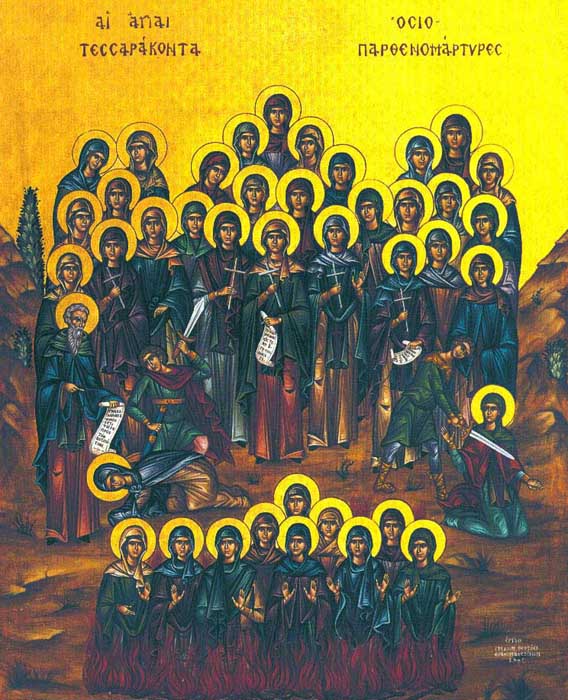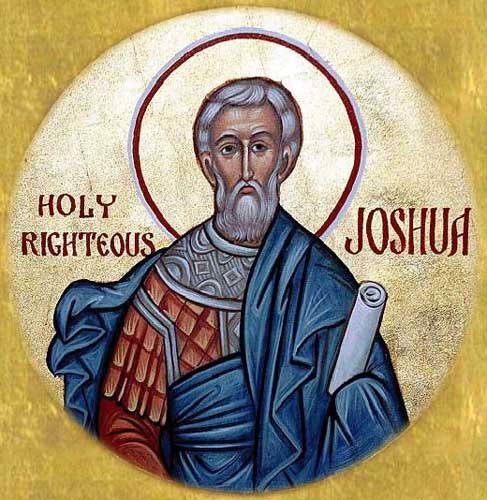Beginning of the Church Year (7521 in Byzantine Reckoning).
The First Ecumenical Council [Nicaea, 325] decreed that the Church year should begin on September 1. The month of September was, for the Hebrews, the beginning of the civil year (Exodus 23:16), the month of gathering the harvest and of the offering of thanks to God. It was on this feast that the Lord Jesus entered the synagogue in Nazareth (Luke 4:16-21), opened the book of the Prophet Isaiah and read the words: The Spirit of the Lord God is upon Me; because the Lord hath anointed Me to preach good tidings unto the meek; He hath sent Me to bind up the brokenhearted, to proclaim liberty to the captives, and the opening of the prison to them that are bound; to proclaim the acceptable year of the Lord, and the day of vengeance of our God; to comfort all that mourn (Isaiah 61:1-2). The month of September is also important in the history of Christianity, because Emperor Constantine the Great was victorious over Maxentius, the enemy of the Christian Faith, in September. Following this victory, Constantine granted freedom of confession to the Christian Faith throughout the Roman Empire. For a long time, the civil year in the Christian world followed the Church year, with its beginning on September 1. The civil year was later changed, and its beginning transferred to January 1. This occurred first in Western Europe, and later in Russia, under Peter the Great.Our Venerable Father Simeon the Stylite and his mother.
 He was born in Syria of peasant parents. At the age of eighteen, he left home and was tonsured a monk. He undertook the most difficult ascetic practices, and sometimes undertook a strict fast for forty days. He eventually took upon himself a form of asceticism that was previously unknown. He stood day and night on a pillar, in unceasing prayer. At first, his pillar was six cubits high; he later raised it to twelve cubits, then to twenty-two cubits, then to thirty-six cubits, and finally to forty cubits high. On two occasions his mother Martha came to see him, but he refused to receive her, saying from atop the pillar: ``Do not disturb me now, my mother. If we become worthy, then we'll see each other in the next world.'' St. Simeon endured countless assaults from demons, but he conquered them all by prayer to God. The saint worked many great miracles, healing by word and prayer many who were afflicted. People from all over gathered around his pillar-the rich and the poor, kings and slaves. Simeon helped everyone: healing some of infirmities, comforting those in need, instructing others, and reproaching some who held heretical beliefs. Thus, he turned Empress Eudocia from the Eutychian heresy and brought her back to Orthodoxy. He lived the ascetic life during the reigns of the Emperors Theodosius the Younger, Marcian and Leo the Great. Simeon, the first great stylite in Christianity and a great miracle-worker, lived to be 103 years old. He reposed in the Lord on September 1, 459. His relics were translated to Antioch, to the church dedicated to his name.
He was born in Syria of peasant parents. At the age of eighteen, he left home and was tonsured a monk. He undertook the most difficult ascetic practices, and sometimes undertook a strict fast for forty days. He eventually took upon himself a form of asceticism that was previously unknown. He stood day and night on a pillar, in unceasing prayer. At first, his pillar was six cubits high; he later raised it to twelve cubits, then to twenty-two cubits, then to thirty-six cubits, and finally to forty cubits high. On two occasions his mother Martha came to see him, but he refused to receive her, saying from atop the pillar: ``Do not disturb me now, my mother. If we become worthy, then we'll see each other in the next world.'' St. Simeon endured countless assaults from demons, but he conquered them all by prayer to God. The saint worked many great miracles, healing by word and prayer many who were afflicted. People from all over gathered around his pillar-the rich and the poor, kings and slaves. Simeon helped everyone: healing some of infirmities, comforting those in need, instructing others, and reproaching some who held heretical beliefs. Thus, he turned Empress Eudocia from the Eutychian heresy and brought her back to Orthodoxy. He lived the ascetic life during the reigns of the Emperors Theodosius the Younger, Marcian and Leo the Great. Simeon, the first great stylite in Christianity and a great miracle-worker, lived to be 103 years old. He reposed in the Lord on September 1, 459. His relics were translated to Antioch, to the church dedicated to his name.
Synaxis of the Most Holy Mother of God of Miasena.
The Holy Martyr Aeithalas.

The Forty Holy Women Martyred with their Instructor Ammon the Deacon.
The Holy Martyr Callista and her two Brothers, Evod and Hermogenes.
The Just Joshua, Son of Nun.
 Joshua was the leader of the Hebrew people after the death of Moses. Of several hundred thousand Jews who came out of Egypt, only he and Caleb entered the Promised Land. Joshua lived to be 110 years old, and died approximately 1440 years before the Nativity of Christ. (Read of his faithfulness to God, his works and his miracles in the Book of Joshua.)
Joshua was the leader of the Hebrew people after the death of Moses. Of several hundred thousand Jews who came out of Egypt, only he and Caleb entered the Promised Land. Joshua lived to be 110 years old, and died approximately 1440 years before the Nativity of Christ. (Read of his faithfulness to God, his works and his miracles in the Book of Joshua.)
Respectfully Taken From the:
"The Prologue of Ohrid"
by St. Nikolai of Zica, Serbia(Velimirovic)
No comments:
Post a Comment